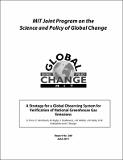| dc.contributor.author | Prinn, Ronald G. | |
| dc.contributor.author | Heimbach, P. | |
| dc.contributor.author | Rigby, Matthew | |
| dc.contributor.author | Dutkiewicz, Stephanie | |
| dc.contributor.author | Melillo, Jerry M. | |
| dc.contributor.author | Reilly, John M. | |
| dc.contributor.author | Kicklighter, David W. | |
| dc.contributor.author | Waugh, Caleb | |
| dc.date.accessioned | 2011-10-17T19:23:30Z | |
| dc.date.available | 2011-10-17T19:23:30Z | |
| dc.date.issued | 2011-06 | |
| dc.identifier.uri | http://globalchange.mit.edu/pubs/abstract.php?publication_id=2161 | |
| dc.identifier.uri | http://hdl.handle.net/1721.1/66300 | |
| dc.description | Abstract and PDF report are also available on the MIT Joint Program on the Science and Policy of Global Change website (http://globalchange.mit.edu/). | en_US |
| dc.description.abstract | With the risks of climate change becoming increasingly evident, there is growing discussion regarding international treaties and national regulations to lower greenhouse gas (GHG) emissions. Enforcement of such agreements is likely to depend formally upon national and sectoral emission reporting procedures (sometimes referred to as “bottom-up” methods). However, for these procedures to be credible and effective, it is essential that these reports or claims be independently verified. In particular, any disagreements between these “bottom-up” emission estimates, and independent emission estimates inferred from global GHG measurements (so-called “top-down” methods) need to be resolved. Because emissions control legislation is national or regional in nature, not global, it is also essential that “top-down” emission estimates be determined at these same geographic scales. This report lays out a strategy for quantifying and reducing uncertainties in greenhouse gas emissions, based on a comprehensive synthesis of global observations of various types with models of the global cycles of carbon dioxide and other greenhouse gases that include both the natural and human influences on these cycles. The overall goal is to establish a global observing and estimation system that incorporates all relevant available knowledge (physical, biogeochemical, technological and economic) in order to verify greenhouse gas emissions, as a key component of any global GHG treaty. | en_US |
| dc.description.sponsorship | Lockheed Martin Corporation and the MIT Joint Program on the Science and Policy of Global Change, which is funded by a consortium of government, industry and foundation sponsors. | en_US |
| dc.language.iso | en_US | en_US |
| dc.publisher | MIT Joint Program on the Science and Policy of Global Change | en_US |
| dc.relation.ispartofseries | ;Report no. 200 | |
| dc.rights | An error occurred on the license name. | en |
| dc.rights.uri | An error occurred getting the license - uri. | en |
| dc.title | A Strategy for a Global Observing System for Verification of National Greenhouse Gas Emissions | en_US |
| dc.type | Technical Report | en_US |
| dc.identifier.citation | Report no. 200 | en_US |
